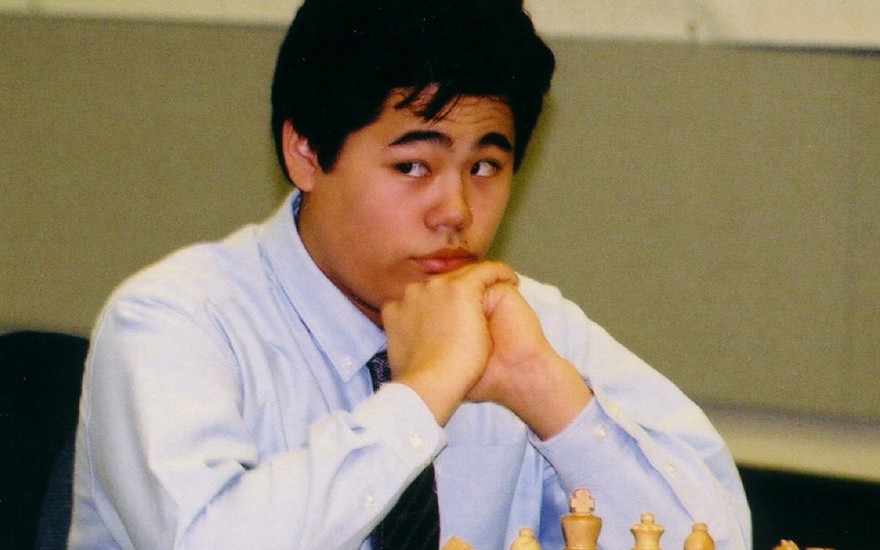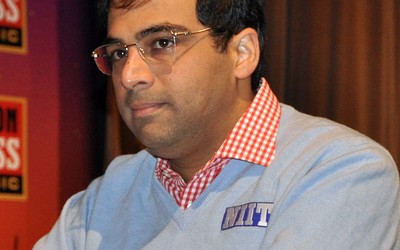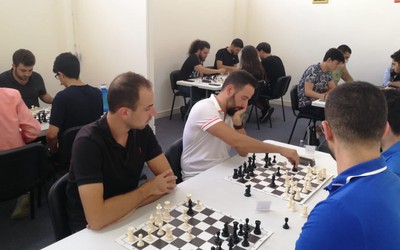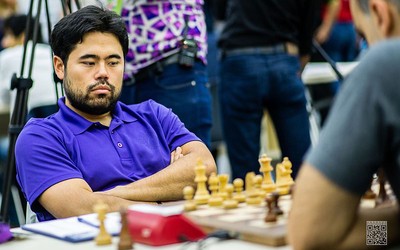
By James F. Perry - Own work, CC BY-SA 3.0, https://commons.wikimedia.org/w/index.php?curid=333270
Nakamura's Secret Weapon Against the Réti Opening - The Ideal Center (Part 2)
In this series of articles, we will deeply analyze a very interesting and novel setup that Hikaru Nakamura employs with some frequency against the Réti Opening.Donations are much appreciated. All of my content and writings will be free forever according to the "Truthdoc code" (to be published some time next year) - help keep such content going strong :). Donate
Be sure to check out the very important introductory article!
Full title (cut short due to space constraints):
Nakamura's Secret Weapon Against the Réti Opening - The Ideal Center with Kingside Castling (Part 2)
Introduction
Without a doubt, going for the ideal center asks Black some very important and tough questions. While Black is busy trying to create a setup that allows them to attack White's king, White is, in turn, arguing that their control of the central squares will give their pieces the increased mobility needed to defuse Black's attack. Objectively, White does have a point: a timely e4-e5 break will expose Black's king, which remains in the center, while Black's over-optimistic attack on the kingside should not amount to much. However, in practice, the attack is especially difficult to tame, and even the objective evaluation of this line, with its Bh3's and h5's, remains reasonable for Black. Note that by castling kingside, White is "castling into" Black's attack, though, again, remember that White is arguing that full-scale development and central breaks will give them enough (and more than enough) counterplay.
Move Orders
Remember that the Nakamura Opening works against White's g3-Bg2 setup. Playing some sort of "pan-Nakamura Opening" against 1. e4 or 1. d4 won't work out as well. With that out of the way, let's consider some other move order nuances one should be aware of. The first five moves which will be employed against the Ideal Center setup, namely, 1...g6, 2...Bg7, 3...d6, 4...Bd7, and 5...Qc8, can be played without any special consideration for move orders. Indeed, they can basically be played on autopilot.
The main consideration when it comes to move orders is whether or not Nc6 should be inserted before Black launches the typical kingside attack with Bh3 and h5-h4. A detailed answer will be provided in the "Objective Analysis" section, but, for now, it is sufficient to know that Nc6 should always be played before Bh3.
Where Do the Pieces Belong?
The answer to this question is highly dependent on how White deals with Black's attack. There are many possible ways to classify the different move orders and setups that can arise out of the Ideal Center with Kingside Castling setup. The simplest way of dividing these different setups is by classifying them into structures where White plays Bxh3 and follows up with Ng5 and those in which they do not.
1) The Ideal Center with Kingside Castling: Bxh3-Ng5
The following position is the typical "ideal center with kingside castling and Bxh3-Ng5" position:
Note that there are simply far too many plans that both sides can go for; that's why I've mentioned that this very long series on the Nakamura Opening, while rather detailed, is not sufficient to cover all the different intricacies of this opening! However, we can still arrive at some general conclusions.
Black's knight will always come to c6, where it will help to support the kingside attack. Again, and as mentioned in the introductory article, because we're covering the Nakamura Opening based on the way Nakamura himself plays it, the pawn on h7 will always be pushed to h5 and then to h4, after which it will capture the g3 pawn. As in most Modern Opening setups, the knight on g8 will usually be developed later on in the game, where both f6 and h6 are possible temporary homes, after which the knight will join the attack from the g4 square.
White, in contrast, can react to Black's aggression in various ways. The queen usually comes to d3, where it paves the way for the two rooks to be connected; however, in some cases, the queen can go to b3 if the pawn on c2 moves to either c3 or c4. At other times, the White queen may also be developed to e2. The dark-squared bishop can usually support a timely e5 break when it's positioned on the f4 square, but it can also be developed to the e3 square, where it lends support to the d4-pawn. The rook on a1 usually comes to d1, while White's b1-knight is sometimes not developed because White goes for c3, or, when it is developed, it usually comes to its most natural square, the c3 square.
2) The Ideal Center with Kingside Castling: Allowing Black's Attack
Not taking on h3 and attacking Black's queen with Ng5 is a sign that White believes that they have enough resources on the kingside to fend off Black's attack; in the meantime, White's play in the center should give them enough of an advantage so that Black's attack is cut from its roots, i.e.: no more Black pieces can join in on the kingside fun. What follows is the typical position that can be said to be the foundation of White's not-taking-on-h3 strategy:
Note that Re1 is included because it is always a useful idea in these types of positions. Again, the queen comes to d3, but, in this position, the dark-squared bishop is better developed to d4 where it can support the e5 break. Both central breaks, namely, e5 and d5, are possible and lead to advantageous positions for White. Note that Black's typical plans are not much changed either, but there is an extra possibility of going e5 and taking with the knight on e5, and should the need arise, recapturing with the bishop on e5.
What Is White Aiming For? (Pawn Structure)
There are several pawn structures that can arise from the ideal center pawn formation; each pawn structure has its own article. Mainly, White can choose to keep the center intact, or go for d5 or e5, each of which result in completely different positions. Details about each resulting pawn structure will be covered in the relevant articles.
Objective Analysis
Note: Don't be fooled by the titles — obviously, all setups will eventually include the Ideal Center! For example, the "White Plays e4-Re1" subtitle can be more fully expressed as: "White Plays e4-Re1 and only after Black has played Qc8-Bd7 and achieved the Nakamura Opening setup, White goes for the Ideal Center"!
Note 2: Nc6 before Bh3 is always preferable — developing pieces and letting one more potential attacker into the game is better than launching the attack immediately.
Note 3: The only 6th (in some lines, 7th) moves that will be considered will be Nc6 and Bh3. For more information as to why that is the case, again refer to the introductory article.
The "Ideal Center with Kingside Castling" will further be split into six relevant important move orders, each of which has its own unique characteristics:
1) White Plays e4-Re1
2) White Plays d4-Re1
3) White Plays d4-Re1 with Bxh3-Ng5
4) White Plays e4-d4 Immediately
5) White Plays e4-d4 Immediately with Bxh3-Ng5
6) White Plays d4-h4
The Games
Enjoy the following selection of 65 annotated games. Again, note that the games won't be very deeply annotated because in this series of articles, the aim is to cover the opening and not game analysis. Just run through the games quickly to get an idea of how superGM Hikaru usually handles the various positions that arise from this opening. Note also that the games have been engine-checked, so analysis is mostly provided at various inflection points — inaccuracies, mistakes, and blunders.
Note: To view all the games, be sure to click down on the dropdown menu or just open the study in another tab.
Games: Takeaway Points
- Most of your opponents, even esteemed GMs, won't play the opening very accurately!
- e5 is a very important idea to be aware of as White and be careful of as Black. If it becomes apparent that White will push e5 and blast open the center, Black should preemptively play e5 to lock down the center.
- f6-e5 and f6-g5 are key ideas, the former of which maintains a strong center, while the latter prepares a kingside attack.
- Rxh4 is a key sacrificial idea, especially combined with Bxd4 ideas (more so when White plays Bh1), which distract the White queen away from the g4 square, paving the way for Black's queen to come to the g4 square and mate White's king.
- The f5 break on the kingside, supported by a knight on e7, is usually a powerful idea in this opening.
- Nh6 ideas are usually good; however, in some cases, a timely Bxh6 can leave Black with a dark-squared bishop that's staring into empty space.
The Verdict
This line / setup is highly principled and one of the best ways of meeting the Nakamura Opening.
Conclusion
In conclusion, the ideal center with kingside castling setup is one of White's most respectable tries against the Nakamura Opening. Playing in swashbuckling style (h5-h4 and Bh3) against this system may not be very sound, but it's not that objectively terrible, and, practically speaking, Black's attack is difficult to deal with. Usually a timely Bxh3 offers White a safe and stable advantage, and sometimes more, but following up with Ng5 is not usually correct. For people who want to really refute this way of playing for Black, an early e5 break might suit their needs. Next up, we're going to take a look at a specific line in the ideal center with kingside castling setup — the line in which White pushes d5 and takes on e5.
More blog posts by FischyVishy

Attacking Chess Patterns: Grand Prix, Queen(1) Attack, and Grand Thorn
In this series of articles, I list and explain all kinds of chess patterns. Chess patterns are recur…
Why Bughouse Is Good for the Environment
Bughouse — Give it a try if you care about planet Earth.
Nakamura's Secret Weapon Against the Réti Opening - Introduction (Part 1)
In this series of articles, we will deeply analyze a very interesting and novel setup that Hikaru Na…
